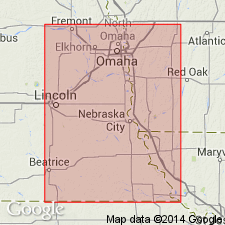
- Usage in publication:
-
- Long Creek limestone bed
- Modifications:
-
- Original reference
- Dominant lithology:
-
- Limestone
- AAPG geologic province:
-
- Forest City basin
Summary:
Pg. 84, 85, 88. Long Creek limestone bed of Elmdale shale member of Wabaunsee formation. Usually weathers buff to yellowish, somewhat cavernous and irregular. Thickness 3.25 to 5 feet in Nebraska and 3 to 6 feet in northeastern Kansas. Underlies Johnson shale and overlies Hughes Creek shale, all in Elmdale shale member. Age is Late Pennsylvanian (Missouri age). Report includes cross sections, measured sections, geologic maps, stratigraphic tables.
Named from exposures on Longs Creek, at the foot of the bluff west of cemetery at Auburn, Nemaha Co., southeastern NE.
Source: US geologic names lexicon (USGS Bull. 896, p. 1212); GNC KS-NE Pennsylvanian Corr. Chart, sheet 1, Oct. 1936; supplemental information from GNU records (USGS DDS-6; Denver GNULEX).
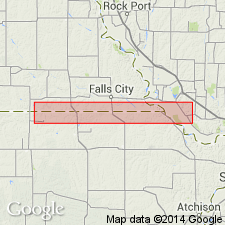
- Usage in publication:
-
- Long Creek limestone member
- Modifications:
-
- Revised
- AAPG geologic province:
-
- Forest City basin
Summary:
Pg. 8. Long Creek limestone member of Foraker limestone formation of Council Grove group. Extended Foraker limestone into Nebraska and divided it into (descending): Long Creek limestone, 3 to 6 feet; Hughes Creek shale, 36 to 38 feet; and Americus limestone, 2 to 3 feet. Age is considered Permian (lower part of Big Blue).
Source: US geologic names lexicon (USGS Bull. 896, p. 1212); GNC KS-NE Pennsylvanian Corr. Chart, sheet 2, Oct. 1936.
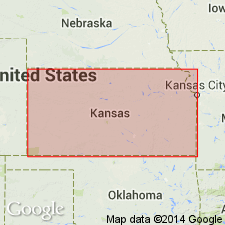
- Usage in publication:
-
- Long Creek limestone member
- Modifications:
-
- Age modified
Summary:
Long Creek limestone member of Foraker limestone of Council Grove group. Transferred this unit to Permian. This change in Permian-Pennsylvanian boundary has not been considered by the USGS for its publications [ca. 1938].
Source: US geologic names lexicon (USGS Bull. 896, p. 1212); GNC KS-NE Pennsylvanian Corr. Chart, sheet 2, Oct. 1936.
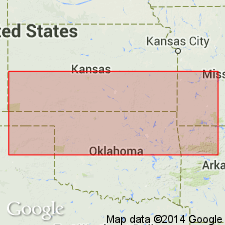
- Usage in publication:
-
- Long Creek limestone member
- Modifications:
-
- Areal extent
- AAPG geologic province:
-
- Chautauqua platform
Summary:
Long Creek limestone member of Foraker limestone. Identifiable in southern Kansas and northern Oklahoma.
Source: US geologic names lexicon (USGS Bull. 1200, p. 2224-2225).
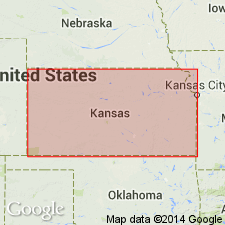
- Usage in publication:
-
- Long Creek limestone member*
- Modifications:
-
- Overview
Summary:
Pg. 168; R.C. Moore and others, 1951, Kansas Geol. Survey Bull., no. 89, 48. Long Creek limestone member of Foraker limestone of Council Grove group. Alternating beds of yellow limestone and shale, or thin-bedded limestone, locally containing abundance of fusulines in northern part of outcrop area; in southern Kansas, light-gray limestone, more or less massive in upper and lower parts and sparsely fossiliferous. Thickness 5 to 8 feet. Overlies Hughes Creek shale member; underlies Johnson shale. Age is Early Permian (Wolfcampian).
Source: US geologic names lexicon (USGS Bull. 1200, p. 2224-2225).
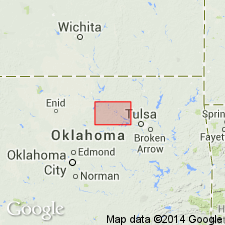
- Usage in publication:
-
- Long Creek limestone member*
- Modifications:
-
- Areal extent
- AAPG geologic province:
-
- Chautauqua platform
Summary:
Pg. 83-85, pls. 1, 2, 3, 4. Long Creek limestone member of Foraker limestone of Council Grove group. In Oklahoma, persists as far south as T. 16 N., in southern Lincoln County. In northern Osage County, consists of shaly limestone and shale and minor amounts of chert. Ranges in thickness from 9.8 to 12 feet. In Pawnee County, consists of interbedded dense gray limestone and gray marly shale; no chert. Thickness as much as 25.3 feet; entire sequence seldom exposed at one place. Overlies Hughes Creek shale member; underlies Johnson shale. Age is Early Permian (Wolfcampian).
Source: Publication; US geologic names lexicon (USGS Bull. 1200, p. 2224-2225).
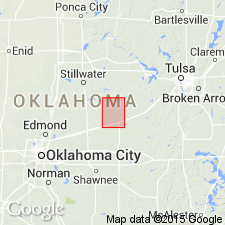
- Usage in publication:
-
- Long Creek limestone member
- Modifications:
-
- Revised
- AAPG geologic province:
-
- Chautauqua platform
Summary:
Pg. 4-6. Long Creek limestone member of Konawa formation. Described in Lincoln County, northern Oklahoma, where it is classified as member of Konawa formation. Thickness 55 to 60 feet. Overlies Americus(?) limestone member; underlies Red Eagle limestone member. [Age is Early Permian (Wolfcampian).]
Source: US geologic names lexicon (USGS Bull. 1200, p. 2224-2225).
For more information, please contact Nancy Stamm, Geologic Names Committee Secretary.
Asterisk (*) indicates published by U.S. Geological Survey authors.
"No current usage" (†) implies that a name has been abandoned or has fallen into disuse. Former usage and, if known, replacement name given in parentheses ( ).
Slash (/) indicates name conflicts with nomenclatural guidelines (CSN, 1933; ACSN, 1961, 1970; NACSN, 1983, 2005, 2021). May be explained within brackets ([ ]).

